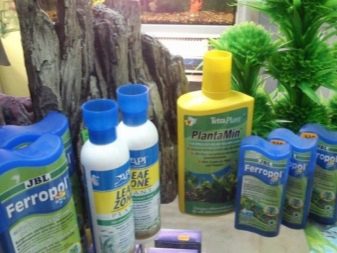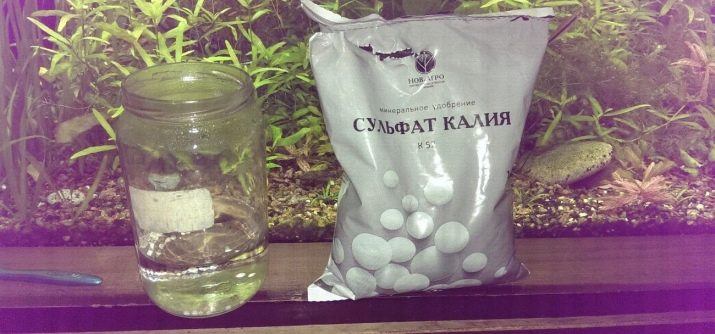Not only the aquarium requires care, but also the algae that live in it. In order for the aquatic flora to fully grow and create a favorable pleasant microclimate, it is necessary to create a nutrient medium for it. Traditionally, aquarium fertilizers are used for this, which include potassium and iron - these microelements contribute to the accelerated growth of algae. If you want to make fertilizers, you can do it yourself at home.

Why are supplements needed?
In order for the aquarium flora to maintain its decorative effect, algae should be fed from time to time with preparations containing micro- and macroelements useful for aquatic plants. Many people use plain blue clay, but it is better to resort to complex supplements with iron, zinc, potassium, as well as phosphorus, sodium and iodine.
The volume and composition of fertilizers used directly depends on a number of factors:
- the volume of aquarium flora in the tank;
- the amount of fluid in the aquarium;
- the intensity of natural light and artificial lighting;
- carbon dioxide concentration in an artificial reservoir;
- water heating temperature.



remember, that biocenoses in artificial reservoirs differ significantly from those occurring on land; therefore, preparations intended for terrestrial flora cannot be taken to feed aquatic plants. The fact is that ordinary plants need nitrogen, phosphorus and potassium.All these microelements are also needed for aquarium species of vegetation, but the dosage should be minimal, since they are already present in the liquid in the form of waste products of fish, amphibians and other inhabitants of an artificial reservoir.
If the dosages are exceeded, then a violation of the microbalance of the tank may occur, which will lead to a deterioration in the appearance of algae.
At the same time and trace element deficiency is dangerous - greenery stops growing, stops multiplying, changes shape and color, which most often also leads to the death of the plant. Therefore, it is extremely important to maintain a strict balance both in the manufacture and application of fertilizers. Follow the recommended dosages exactly.
In order for the plants to fully grow and develop in the water, they need oxygen and a little carbon dioxide. In addition, algae need nitrogen, which they use to form protein compounds. Potassium is also needed. - He is responsible for photosynthesis, and its lack leads to stunting and protein deficiency. All this causes a discoloration of algae and other aquatic plants. If your pets do not have enough iron, then whitish spots will appear on the surface of the leaf plates.
If you notice that the leaves of the plant have become dark and have whitish spots on them - most likely, the plant suffers a lack of phosphorus. All these signs should be considered when choosing a fertilizer.


Preparations that promote the full growth and further reproduction of algae are sold in pet stores, but if you wish, everyone can cook them on their own.


Micronutrient recipes
To make a mixture of micro and macro fertilizers for aquatic life, you will need the following tools and materials:
- Libra;
- thermometer;
- latex gloves;
- wooden sticks;
- flasks;
- measuring cup;
- chemical components of the mixture.




Let us dwell on recipes for drugs that you can always make at home yourself.
Aquarists recommend the following components for the preparation of microfertilizers:
- boric acid;
- copper;
- zinc;
- ammonium molybdate;
- manganese sulfate.




Prepare clean water in advance - you will need about 0.5 l. In a suitable container, the water must be heated to 30-40 degrees. The components of the mixture are alternately introduced into the water, mixed until they are completely dissolved and an additional 0.5 l of warm liquid is added.
The resulting composition is poured into the aquarium daily in a ratio of 0.5 ml per 100 liters of liquid. The maximum permissible concentration is 1 ml per 100 liters.
Another effective recipe for complex fertilizer includes the following ingredients:
- sulfates of iron, magnesium, copper and zinc;
- citric acid.



All components are separately added to distilled warm water, thoroughly mixed until the dry components are completely dissolved and insisted for about 2 hours. After this, add 4 ampoules of vitamins (ferovit and cytovit), 2 ampoules of soluble vitamin B12, as well as 20 ml of sulfuric acid (you can replace it with 10 ml of sulfuric acid + 10 ml of boric acid).
If aquarium plants lack phosphorus, 75 grams of potassium phosphate must be mixed and diluted in 1 liter of water. The resulting solution is added to the tank from a proportion of 1 ml for every 100 liters of water.
With nitrogen deficiency, a nitrate composition is prepared, for which 65 grams of potassium nitrate are taken and dissolved in 1 liter of heated liquid. Make a solution in the same volume as phosphate.
To make a potash mixture, 110 grams of potassium sulfate is poured into 1000 ml of heated water and dissolved. The composition is introduced into water according to the scheme: 1 ml of the mixture per 10 liters of liquid.

Where to buy the original components?
All micronutrient-based algae top dressing ingredients can be bought in specialty stores that sell chemicals.Unfortunately, such outlets in most cases are found only in large cities, and in small towns finding reagents can present some difficulties. Nevertheless, there is a way out - most likely, you will find everything you need in shops for gardeners and gardeners, pharmacies, as well as hardware stores.
Fertilizers for algae are prepared very simply, while most aquarists believe that independent production will be more profitable than buying brand-name products. In addition, these solutions can be stored for a long time (required in a cold, dark place). The dosage of the composition should be changed depending on the volume of water, the level of illumination and, of course, on the condition of the plants.
Some believe that homegrown recipes are worse and weaker than ready-made ones, but this is not so. Of course, you will not get complete identity with branded compositions, since no brand will open its technology and recipe. However, your analog will not be worse and the likelihood that you will be satisfied with your own product is very high.


Rarely, but there are times when top-dressing made at home does not work, but only exacerbates the poor condition of the algae. The following phenomena can be observed:
- leaf deformation or destruction occurs;
- the plant does not grow as fast as we would like;
- algae outbreaks occur.
In any of these cases need to completely change one composition of fertilizers on another and determine the optimal dosage by trial and error.



But the opinion that homemade fertilizers are cheaper than purchased is wrong - the cost of the reagents themselves is low, but do not forget about the initial costs that will be required to purchase the equipment necessary for the manufacture of mixtures.
About aquarium fertilizer with your own hands, see the next video.










